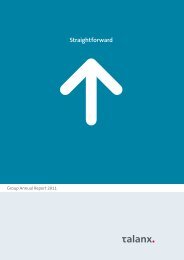Values
Values
Values
You also want an ePaper? Increase the reach of your titles
YUMPU automatically turns print PDFs into web optimized ePapers that Google loves.
trigued by the articles about foreign<br />
countries and cultures, and after six issues,<br />
the new monthly already had<br />
more than 200,000 readers and was<br />
turning a profi t.<br />
As the magazine was so successful<br />
in Germany, G+J decided to take “Geo”<br />
to the United States, the biggest magazine<br />
market in the world. The company<br />
was willing to bet that stories about<br />
Bengal tigers and desert fossils would<br />
interest Americans just as much as Germans.<br />
The articles would only have to<br />
be translated into English.<br />
In 1979, “Geo” appeared on the U.S.<br />
market – and was a huge fl op. For years,<br />
the publishing managers at G+J did<br />
everything they could to make the U.S.<br />
edition a success, in vain. “Too expensive,<br />
too European, too environmental<br />
and too political,” the publishers were<br />
forced to conclude. “When I became<br />
CEO of G+J in 1981, “Geo USA” was already<br />
a hopeless case, and the board<br />
decided to sell. By that time, we’d lost<br />
about 30 million German marks (15<br />
million euros),” remembers Gerd<br />
Schulte-Hillen, who continued to serve<br />
as the head of G+J until 2000.<br />
At the same time as the U.S. version,<br />
G+J also brought out a French version,<br />
and faced similar diffi culties.<br />
There was no magazine like “Stern” to<br />
Editor-in-chief Peter-Matthias<br />
Gaede consults his head of<br />
photography, Ruth Eichhorn,<br />
on photo selection<br />
– 14 –<br />
serve as a trusted link to win over subscribers.<br />
And the French prefer to buy<br />
magazines spontaneously at a kiosk<br />
rather than take out a subscription.<br />
Axel Ganz, who had moved to Paris to<br />
head up the French subsidiary in<br />
charge of “Geo,” responded to these<br />
cultural differences. He made changes<br />
to the cover so that the magazine was<br />
more visible on the shelf. From the<br />
start, he was convinced that French<br />
“Geo” could only be successful if it had<br />
its own editorial team. It was a risky and<br />
expensive approach, but it worked. The<br />
local editorial team moved French topics<br />
into the spotlight, set their own focus,<br />
and increasingly found favor with<br />
readers. By the mid-1980s, circulation<br />
had reached more than 800,000 copies.<br />
Here, unlike in the U.S., determination<br />
paid off. Strengthened by his success in<br />
France, Axel Ganz launched a Spanish<br />
edition of “Geo” in 1987, modeled on<br />
the French edition.<br />
By this point, “Geo” had long since<br />
separated from “Stern” to establish its<br />
own editorial team for the domestic<br />
market in Germany. Since contributors<br />
to the magazine often spent several<br />
weeks on location researching a single<br />
topic, a natural next step was to print<br />
monothematic, in-depth special editions.<br />
At their inception, the biannual<br />
“Specials” focused on very<br />
different topics, such as pho-<br />
“Geo’s” hot air balloon,<br />
photographed on the “Geo”<br />
Day of Species Diversity, 2007,<br />
in Crawinkel, Germany<br />
tography, weather, or space. But soon<br />
they focused on destinations. “People<br />
who were looking for information on a<br />
certain city or country suddenly found<br />
“Geo” special editions at the bookstore,”<br />
says current publishing manager Gerd<br />
Brüne, adding: “These magazines frequently<br />
appealed to people who were<br />
nothing like our core reader.” Many special<br />
editions became valuable collectors’<br />
items which continued to sell well even<br />
years after they were fi rst published.<br />
The knowledge of the contributors,<br />
and their skill in turning complicated<br />
subjects into easy-to-read copy, led to<br />
the launch of a second special edition series<br />
in 1987: “Geo Wissen.” The editorial<br />
team sought to present scientifi c topics<br />
from the fi elds of technology, natural science,<br />
and medicine in a way that was<br />
easily understandable for lay people. By<br />
this time, “Geo” had become a household<br />
name in Germany, and in addition to the<br />
regular monthly issue, many readers also<br />
subscribed to the specials.<br />
From an economic point of view, it<br />
was clear that there was a lot of potential<br />
in founding a family of magazines<br />
under the strong “Geo” name. But the<br />
idea of starting a travel magazine didn’t<br />
go over well with the journalists. “Many<br />
of our colleagues associated it with rating<br />
hotels and swimming pools, and<br />
were worried about their integrity.<br />
1<br />
2<br />
1 | “Geo” founder Rolf Gillhausen<br />
served as editor-in-chief until 1978<br />
2 | The first cover of “Geo-Wissen”<br />
in 1987
















